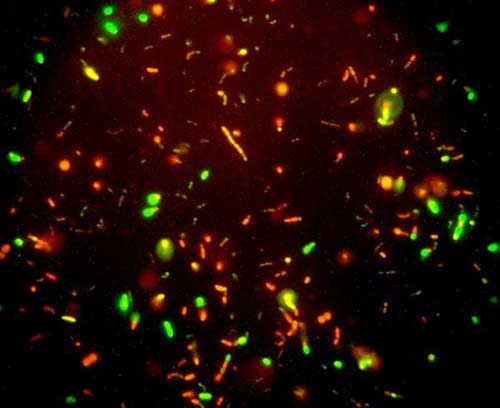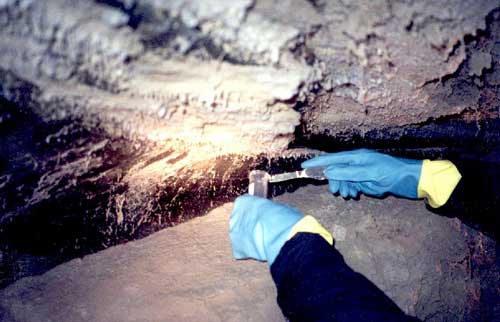 by Ned Rozell March 04, 2005
"When they thawed out, they immediately started swimming," said Hoover, an astrobiologist with NASA's National Space Science and Technology Center in Huntsville, Alabama. "These guys had been frozen since the Pleistocene, and here they were swimming around."  Photo courtesy Richard Hoover. Resurrected after 30,000 years, those bacteria may be proof that life can exist on Mars and other planets, Hoover said. He and his colleagues recently authored a paper in which they introduced the world to Carnobacterium pleistocenium, bacteria known to exist only one place in the world-the Fox permafrost tunnel. The Fox permafrost tunnel dates back to 1965, when engineers for the Army's Cold Region Research and Engineering Laboratory finished drilling a tunnel 360 feet into a hillside north of Fairbanks. Large enough to walk in, the tunnel stays below freezing all year; from its walls jut ancient bones, mosses, soils and ice wedges. The bottom of a frozen lake in a tunnel wall grabbed Hoover's attention in 1999 when he came to Alaska to scout for life in the ice. Hoover saw a golden brown layer at the base of an ancient pond. Thinking the ice contained diatoms-forms of algae that often settle in lake bottoms-he tapped his stainless steel sampling tool into the tunnel wall and dropped a plug of brownish ice into a sealed tube. To check what he had, he took a small sample to microbiologist Joan Braddock's lab at UAF. "The golden brown stuff wasn't diatoms," Hoover said. "That's when we watched them swimming around under the microscope. At that point, we knew we had an assemblage of rod-shaped bacteria, but no one knew if they were common or something totally different."  Photo courtesy Richard Hoover.
Hoover is excited to know that the little creatures suspended in the permafrost hint that life could survive on other planets. "It's another point of evidence that microorganisms are preserved in ice and can remain viable for long periods of time," he said. "If life has ever existed on Mars, it could have been preserved in an ancient sea of ice, like the one that was just discovered on Mars." Hoover also said the discovery proves the importance of the Fox permafrost tunnel, maintained by the U.S. Army Cold Region Research and Engineering Laboratory at Fort Wainwright. "There's only two places like that on planet Earth," Hoover said. "One in Siberia in Yakutsk Russia, and the other one in Fairbanks, Alaska. It's absolutely clear that the Fox tunnel is a valuable planetary resource."
This column is provided as a public service by the Geophysical Institute, University of Alaska Fairbanks, in cooperation with the UAF research community. Ned Rozell ( nrozell@gi.alaska.edu ) is a science writer at the institute.
|